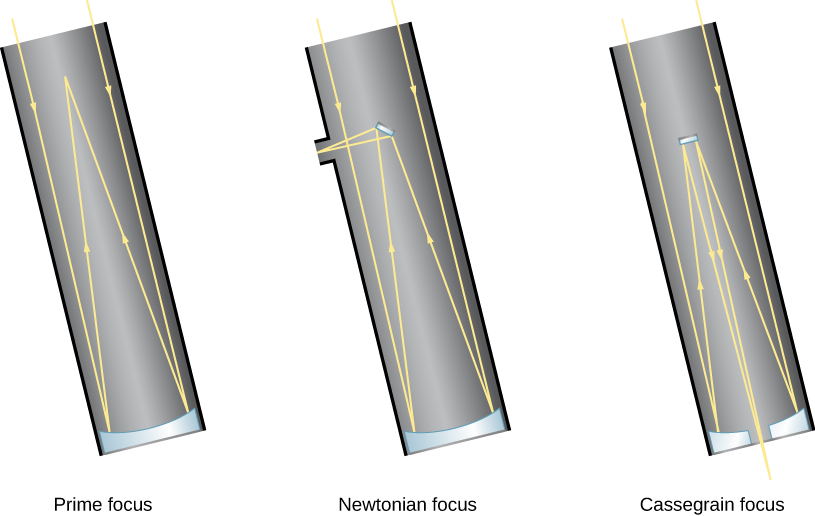| << Chapter < Page | Chapter >> Page > |
In a reflecting telescope, the concave mirror is placed at the bottom of a tube or open framework. The mirror reflects the light back up the tube to form an image near the front end at a location called the prime focus . The image can be observed at the prime focus, or additional mirrors can intercept the light and redirect it to a position where the observer can view it more easily ( [link] ). Since an astronomer at the prime focus can block much of the light coming to the main mirror, the use of a small secondary mirror allows more light to get through the system.

If the astronomy course you are taking whets your appetite for exploring the sky further, you may be thinking about buying your own telescope. Many excellent amateur telescopes are available, and some research is required to find the best model for your needs. Some good sources of information about personal telescopes are the two popular US magazines aimed at amateur astronomers: Sky&Telescope and Astronomy . Both carry regular articles with advice, reviews, and advertisements from reputable telescope dealers.
Some of the factors that determine which telescope is right for you depend upon your preferences:
You may not know the answers to some of these questions yet. For this reason, you may want to “test-drive” some telescopes first. Most communities have amateur astronomy clubs that sponsor star parties open to the public. The members of those clubs often know a lot about telescopes and can share their ideas with you. Your instructor may know where the nearest amateur astronomy club meets; or, to find a club near you, use the websites suggested in Appendix B .
Furthermore, you may already have an instrument like a telescope at home (or have access to one through a relative or friend). Many amateur astronomers recommend starting your survey of the sky with a good pair of binoculars. These are easily carried around and can show you many objects not visible (or clear) to the unaided eye.
When you are ready to purchase a telescope, you might find the following ideas useful:
A telescope collects the faint light from astronomical sources and brings it to a focus, where an instrument can sort the light according to wavelength. Light is then directed to a detector, where a permanent record is made. The light-gathering power of a telescope is determined by the diameter of its aperture, or opening—that is, by the area of its largest or primary lens or mirror. The primary optical element in a telescope is either a convex lens (in a refracting telescope) or a concave mirror (in a reflector) that brings the light to a focus. Most large telescopes are reflectors; it is easier to manufacture and support large mirrors because the light does not have to pass through glass.

Notification Switch
Would you like to follow the 'Astronomy' conversation and receive update notifications?